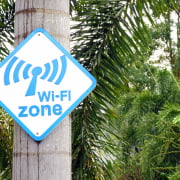WiFi 6 for Municipalities is said to have increased speed, efficiency, and device management that provides better user experience in congested areas such as stadiums, campuses, and cities.
But is this new standard for WiFi technology so new that only cities should start planning for it? Or, could municipalities start reaping benefits that match their goals, budget, and operations, too?
The only way to answer this question is to look at the wireless performance municipalities are challenged with now, and the performance they need to provide in the future to measure up to their city counterparts.
Let’s look at some real-world WiFi challenges for municipalities and compare to WiFi 6 capabilities.
Municipality as a Service Provider
Big city benefits with small-town security and hospitality. That’s what a lot of municipalities are aiming for.
It’s why municipalities act as a service provider, building an IT network so businesses, residential areas, education, and healthcare facilities can provide the best experience to its constituents. Some are even following their city counterparts and deploying “smart” initiatives. Although the organizations and businesses served within a municipality vary, all share a common challenge. They all have more services, devices, and data dependent on a wireless network.
Let’s take a look at some of the most common wireless challenges municipalities face.
Slower Internet in Shared Spaces
Noticing that parks, waiting rooms, classrooms, and anywhere people gather becomes a spot for slower WiFI?
This is because today’s devices, such as mobile phones, are requesting more high-bandwidth applications ranging from social media to streaming video. It doesn’t help that more people, ranging in all ages, have a least one device.
With the current standard of WiFi, multiple devices request data from an access point at the same time, but are only serviced one at a time. It’s like going to a restaurant where everyone can put their food order in at the same time, but the orders are made and delivered one at a time. This is one of the main reasons the WiFI slows down when people come together in big groups.
This brings us to…
Businesses and Facilities Struggle to Keep Up with Industry Technology
Not only is slower WiFI an annoyance when attending school sporting events, charity runs, or parades where people want to share photos and videos on social media.
It creates problems when businesses and facilities try to adopt the latest standard of technology for their industry.
Consider the classroom environment where multiple students are trying to download homework from an application on a tablet. Think of healthcare facilities where more mission-critical medical devices are going wireless.
Wireless medical devices, such as EKG/ECG, patient monitoring, and imaging system devices are booming within the healthcare market. A wireless network unable to handle this additional traffic means these critical medical devices, that are portable for better performance, are either not adopted by the healthcare facility or have performance problems.
One of the ways CommScope’s Wifi 6 wireless access points tackles this problem is by improved MU-MIMO (“Multiple User, Multiple-Input, Multiple-Output”) and Orthogonal Frequency-Division Multiple Access (OFDMA). This combined technology lets more devices access and retrieve data at the same time, versus a one-by-one service. Not to get too technical, but Wi-FI 6 divides channels and frequency to allow both high and low bandwidth applications to perform simultaneously.
This means Pat can sit in the hospital waiting room and watch YouTube videos from a mobile phone without interfering with the wireless medical devices in the hallways and nearby rooms.
Near-Future Plans for Internet-of-Things
Are more discussions brought up in council meetings about how to leverage Internet-of-Things (IoT)?
Cities and municipalities across Texas, Arkansas, Colorado and the nation are deploying “smart” initiatives to better regulate lighting, water, electricity, and security cameras.
For the reasons listed above, adding more IoT sensors and infrastructure will demand more from a wireless network not built to move so much low and high-bandwidth traffic.
Co-Channel Interference Degrading the Network
Does a long list of available networks show up when you go to your phone (or other device’s) WiFi settings?
Up until now, the solution to meeting wireless needs was to add more access points. This creates a lot of “noise” and requires extra work for your devices to talk to access points. The high co-channel interference degrades the network because the access points are less available as they constantly react to the noise in the environment.
We’re seeing this happen in dense areas from parks, shared retail areas, and residential areas. For example, the access points in people’s homes interfere with the school(s) in the neighborhood.
WiFi 6 access points allows for a color coding of the different broadcast service sets or SSIDs. This means it’s able to group devices in such a way that the access point can currently transmit data to multiple devices in a congested area within those broadcasted network SSIDs, eliminating much of the co-channel interference.
Shorter Battery Life for More Devices
Notice battery life draining from phones, tablets, hand-held scanners, and other devices?
As mentioned above, devices are always searching and requesting for WiFi access. This drains the battery power.
This changes with WiFi 6 because the access point alters data packetization so the devices aren’t requesting access unless the device needs to. This new Target Wake Time is the function that allows an access point to define a specific time or set of times for individual devices to access the wireless network.
This is important for industries like education where tablets are used for digital learning and education. Other environments where this is useful include logistics and warehouses where handheld scanners are used.
Infrastructure Refresh Is Coming Up
Is a refresh coming up? This is a great time to identify what infrastructure is meeting the new WiFi 6 standard.
Some manufacturers take extra steps to make the transition easier. For example, CommScope WiFi 6 access point radios can support up to 10 gigabytes of data. Most ethernet ports only support one gigabyte. That’s why the access points are usually shipped with an ethernet port that supports either 2.5 or 5 gigabytes.

Next Steps for Municipalities
Are any of these situations experienced by your municipality?
The good thing about WiFi 6 is that a lot of the features are backward compatible. For example, Commscope’s Wi-FI 6 Access Points are completely client agnostic because many of the benefits happen on the access point infrastructure side.
In our next post, we’re sharing the steps you can take to start preparing for WiFi 6 adoption.
Sign up for our email list to make sure you don’t miss it.
If you enjoyed this article, you may find How Service Providers Will Support 5G Demands interesting.
Partnership
This article is brought to you by CommScope. CommScope and the recently acquired ARRIS and Ruckus Networks are redefining tomorrow by shaping the future of wired and wireless communications.






Leave a Reply
Want to join the discussion?Feel free to contribute!